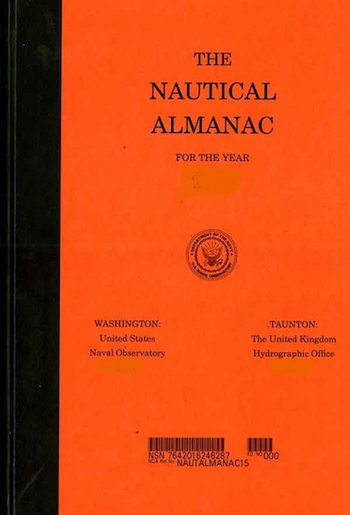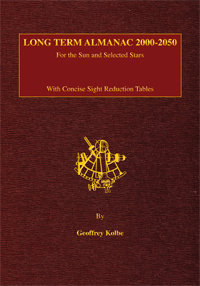In keeping with our budget-rate celestial navigation discussion, here are three different publications, each $30 or less, which are self-contained methods of deriving a three-body celestial fix, and the pros and cons of each.
Nautical Almanac with NAO Tables
Price: $30
Objects useable: Sun, moon, planets, stars
Duration: 1 year
Ease of use: Almanac moderately easy, NAO tables moderately easy with good workform. Included instructions barely usable.
Pros: Can use essentially every body visible in sky. Designed for marine navigation.
Cons: Requires 2102d Starfinder or equivalent for sight planning. NAO tables make necessary sacrifice of simplicity for significantly smaller size, by turning each navigational triangle into two right triangles. Elegant solution, but not very transparent for user.
Kolbe Long Term Almanac
Price: $30
Objects useable: Sun and stars
Duration: 50 years
Ease of use: Usable with good workforms. Sight reduction method is same NAO/Davies tables used in Nautical Almanac.
Pros: Physically smallest of all three methods. Can be used for as long as an individual would likely need to use it.
Cons: Requires 2102d Starfinder or equivalent for sight planning. Most difficult of the three methods discussed here.
Pub 249 vol 1
Price: $20
Objects useable: Stars only.
Duration: 10 years
Ease of use: Extremely easy to use. Sight reduction integral to method and not an additional step.
Pros: Utter simplicity and allows easy precomputation of sights, yet yields a good three-body fix.
Cons: Does not allow you to use brightest objects in sky (sun, moon, Venus and Jupiter). Designed for air navigation, so some information needs to be copied and pasted into book from Nautical Almanac or other source, such as Dip, Altitude Correction and times of twilight. Weird use of precession and nutation rather than simply correcting GHA of Aries for each year, there is some advantage to using GHA Aries from Nautical Almanac as well, but this is not strictly necessary.
I'm going to use 249 volume 1 for my test because it is cheapest and easiest. But if I were going across an ocean and was limited to only one publication for celestial navigation I would use the Nautical Almanac, because I prefer to be able to use the moon and planets when they're available.



Remind me to take your celnav classes next spring. I can't wait.
ReplyDelete-Doug